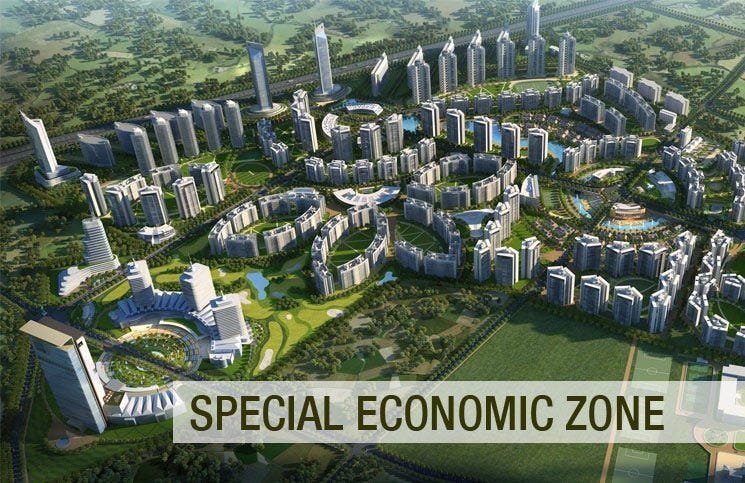Special Economic Zones: Catalysts for Economic Development
Special Economic Zones (SEZs) are designated areas within a country that operate under unique economic regulations different from the rest of the country. These zones are designed to attract foreign and domestic investment by offering incentives such as tax breaks, streamlined regulations, and improved infrastructure. By fostering a conducive environment for business, SEZs aim to stimulate economic growth, create jobs, and promote industrial development. This article explores the concept of SEZs, their benefits, challenges, and global examples.
What Are Special Economic Zones?
Special Economic Zones (SEZs) are geographical regions where business and trade laws differ from those in the rest of the country. The primary objective of SEZs is to enhance economic activity by creating favorable conditions for investment and enterprise. SEZs can vary in their focus, including industrial, technological, and export processing zones.
Key Features of SEZs
- Incentives and Benefits
- Tax Breaks: SEZs often provide significant tax incentives, such as reduced corporate tax rates, exemptions from import/export duties, and value-added tax (VAT) reductions.
- Regulatory Flexibility: Businesses in SEZs typically benefit from simplified regulatory processes, reduced bureaucratic hurdles, and expedited approvals for permits and licenses.
- Infrastructure: SEZs are usually equipped with state-of-the-art infrastructure, including modern transportation links, utilities, and telecommunications, to support business operations.
- Focused Objectives
- Economic Diversification: SEZs often aim to diversify the economy by promoting sectors such as manufacturing, technology, and services.
- Employment Generation: By attracting investments, SEZs create job opportunities and contribute to local economic development.
- Export Promotion: Many SEZs are designed to boost export-oriented industries, thereby enhancing foreign exchange earnings.
- Governance and Administration
- Autonomous Management: SEZs are typically managed by dedicated authorities or agencies that operate with a degree of autonomy from national or local governments.
- Customized Regulations: SEZs can have specific regulations tailored to their sectoral focus, allowing for greater flexibility in business operations.
Benefits of Special Economic Zones:
- Economic Growth and Development
- Investment Attraction: SEZs attract both foreign and domestic investments by offering a business-friendly environment and financial incentives.
- Industrialization: SEZs can spur industrial development and technological advancement, contributing to broader economic growth.
- Job Creation
- Employment Opportunities: SEZs generate jobs directly within the zones and indirectly in the surrounding areas through increased economic activity.
- Skill Development: The presence of diverse industries in SEZs can lead to skill development and capacity-building for the local workforce.
- Infrastructure Improvement
- Enhanced Facilities: SEZs often drive improvements in infrastructure, such as roads, ports, and utilities, benefiting both businesses and local communities.
- Regional Development: SEZs can promote regional development by attracting investment to less economically developed areas.
- Export Promotion
- Foreign Exchange Earnings: By focusing on export-oriented industries, SEZs contribute to foreign exchange earnings and balance of payments improvements.
- Global Market Access: Businesses in SEZs gain access to global markets, enhancing their competitiveness and growth prospects.
Challenges and Criticisms:
- Economic Disparities
- Uneven Development: SEZs can sometimes exacerbate economic disparities by concentrating development in specific areas while neglecting other regions.
- Local Impact: The benefits of SEZs may not always translate into broader regional development or improvements in local living standards.
- Regulatory and Administrative Issues
- Governance Challenges: Ensuring effective management and oversight of SEZs can be challenging, especially in terms of maintaining transparency and preventing corruption.
- Compliance and Enforcement: Differences in regulations between SEZs and the rest of the country can create complexities in compliance and enforcement.
- Environmental and Social Concerns
- Sustainability: Rapid industrialization within SEZs can lead to environmental degradation if not managed properly.
- Social Impact: Large-scale projects and influxes of workers can impact local communities, leading to potential social tensions and disruptions.
Global Examples of Successful SEZs:
- Shenzhen, China
- Overview: Shenzhen, established as China’s first SEZ in 1980, has evolved into a global economic powerhouse and technology hub.
- Impact: Shenzhen’s success is attributed to its business-friendly environment, significant foreign investment, and rapid industrialization, contributing to China’s economic transformation.
- Dubai, United Arab Emirates
- Overview: Dubai is home to several SEZs, including Jebel Ali Free Zone (JAFZA) and Dubai Internet City, focusing on logistics, technology, and trade.
- Impact: These zones have played a crucial role in Dubai’s economic diversification and growth, transforming it into a major global trade and business center.
- Maquiladora Zones, Mexico
- Overview: The Maquiladora Zones along the US-Mexico border focus on manufacturing and assembly for export.
- Impact: These zones have contributed to job creation and industrial development in northern Mexico, benefiting from proximity to the US market.
Conclusion:
Special Economic Zones (SEZs) play a significant role in stimulating economic growth, creating jobs, and promoting industrial development. By offering tailored incentives and creating business-friendly environments, SEZs can drive investment and innovation. However, addressing challenges related to economic disparities, regulatory complexity, and environmental impact is crucial for ensuring that SEZs contribute to sustainable and inclusive development. As global examples demonstrate, successful SEZs can transform regions and contribute to national economic success, but careful planning and management are essential to maximize their benefits and mitigate potential drawbacks.











Simply desire to say your article is as surprising The clearness in your post is simply excellent and i could assume you are an expert on this subject Fine with your permission let me to grab your feed to keep up to date with forthcoming post Thanks a million and please carry on the gratifying work